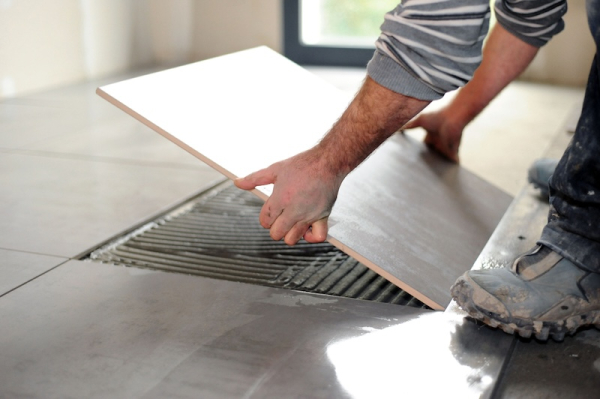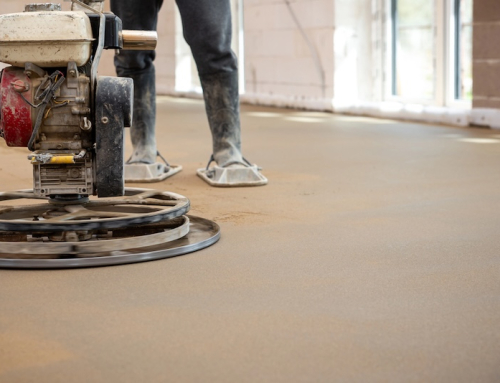Flooring decisions can quietly drain your budget if you focus only on the upfront cost. For commercial property owners and facility managers, choosing between tile and a poured concrete floor isn’t just about looks; it’s about durability, maintenance, and long-term ROI.
Tile is a familiar choice, but it comes with grout issues, breakage, and higher upkeep. Concrete, on the other hand, offers strength and seamless coverage, but may seem more expensive at first glance.
The real question is: which one holds up better over time, and where does your money actually go? Whether you’re planning a retail build-out, restaurant renovation, or warehouse upgrade, this comparison breaks down the full lifecycle cost of both options so you can invest smarter and avoid surprises later.
Upfront Installation Costs: Tile vs Poured Concrete
When evaluating tile and poured concrete floors, it’s not only about the surface that matters; it’s what goes into getting it installed. Material costs, labor intensity, and prep work can shift total expenses fast, especially in large commercial projects. On top of that, installation speed affects your bottom line, particularly if business operations must pause.
Material and Labor Differences
A poured concrete floor typically uses the existing concrete slab as a base, which reduces materials and speeds up the process. Tile, on the other hand, requires several layers, including mortar, grout, and potentially underlayment, plus careful hand installation.
Typical Installation Costs (Per Square Foot)
|
Flooring Type |
Basic Finish |
High-End Finish |
|---|---|---|
|
Poured Concrete Floor |
$2–$6 |
$15–$30+ (decorative) |
|
Tile (Stone/Ceramic) |
$7–$45 |
$50–$100+ (luxury tile) |
Cost Factors That Influence Pricing
- Subfloor Prep – Leveling, patching, or adding moisture barriers can add $1–$10/sq. ft.
- Materials – Grout and mortar for tile; sealer or stain for concrete
- Design Complexity – Multiple colors, polish, or patterned tile layouts increase labor
Time and Downtime Considerations
Installation speed plays a big role in both cost and business disruption. A poured concrete floor can be installed quickly, especially over large areas, but it needs time to cure. Most concrete surfaces require 7 to 28 days before they’re ready for foot traffic or finishing, depending on the mix and moisture levels.
Tile installation takes more time because each piece is set by hand. However, once the grout cures—usually within 24 to 72 hours—the floor is ready to use.
For businesses, downtime means more than waiting. It can lead to:
- Missed revenue from closures
- Workflow interruptions
- Added labor to make up lost time
If speed matters, tile may be the better choice. But if the project timeline is flexible, a poured concrete floor can offer better value over time with less maintenance and fewer repairs.
Maintenance Over Time
Maintenance is critical in the long-term cost of any floor. Whether you’re working with tile or a poured concrete floor, each comes with its own care needs, and the difference adds up over time.
Tile Grout Issues vs Seamless Concrete Surfaces

Tile floors have one big drawback: grout. Grout stains easily, cracks under pressure, and needs rework every few years. In commercial spaces, it traps dirt and spills, which means deeper, more frequent cleaning. If a tile cracks, it usually needs to be cut out and replaced, which adds labor and cost.
A poured concrete floor has no joints or grout lines. When appropriately sealed, it resists stains and moisture and is easy to clean with basic tools. Polished concrete floors or stained concrete finishes offer a seamless look and a low-maintenance surface that holds up well in busy environments.
Long-Term Cleaning & Resealing Needs
Concrete floors should be resealed every few years, depending on traffic. Polished concrete lasts longer with regular upkeep. Tile, while simple to mop, often needs extra cleaning and spot repairs due to grout issues.
Over 10 years, tile can cost more to maintain—especially if repairs or regrouting are frequent. Concrete surfaces, on the other hand, stay predictable. With fewer moving parts and less day-to-day fuss, they offer a cleaner, more cost-effective solution.
Durability and Damage Risk in High-Traffic Areas
In high-use spaces, floors take a beating. What matters is how well the surface holds up under pressure and how often it needs fixing.
Tile Chips, Breakage, and Replacement
Tile can crack or chip if something heavy falls on it. This is common in kitchens, warehouses, or retail spaces where tools, carts, or furniture are moved around. Finding a matching tile later can be tough, and damaged spots can become tripping hazards if not addressed quickly.
How Concrete Holds Up to Wear and Tear
A poured concrete floor is built for tough use. It handles foot traffic, rolling carts, and heavy equipment without shifting or cracking. In places like restaurants, schools, or industrial sites, it stays solid even after years of use. Adding a polished or sealed finish helps protect against stains and chemicals. That means fewer repairs, less disruption, and more peace of mind.
Here is a 300-word section for the next part of your blog, written to match the tone and structure of previous sections. It uses light transitions, clean language, and practical comparisons while integrating the keyword poured concrete floor and related terms naturally:
Total Cost of Ownership (TCO): A 10-Year View
Installation cost is only part of the equation. What you spend over the next 10 years—including maintenance, repairs, and replacements—can make or break the value of a flooring choice.
Cost Comparison Table (Install + Maintenance + Repairs)
To compare, let’s look at a 1,000 sq. ft. commercial space using mid-range materials and standard maintenance schedules.
|
Cost Category |
Poured Concrete Floor |
Tile Flooring |
|---|---|---|
|
Initial Install |
$8,000 – $12,000 |
$12,000 – $20,000 |
|
Maintenance (10 yrs) |
$2,000 – $3,000 |
$4,000 – $6,000 |
|
Repairs |
Minimal (if sealed) |
$2,000+ (grout, cracks) |
|
10-Year Total |
$10,000 – $15,000 |
$18,000 – $28,000 |
Concrete flooring costs less over time, especially in commercial spaces that see constant foot traffic or equipment movement. Polished concrete floors and stained concrete finishes resist wear and need less upkeep compared to tile with grout.
Which Delivers Better ROI for Commercial Use?
The poured concrete floor comes out ahead in both durability and cost efficiency. With fewer materials to replace and a simpler maintenance routine, it keeps operational costs low. Most repairs are cosmetic and rarely disrupt business.
Tile can offer aesthetic variety but brings a higher risk of damage, especially in high-traffic or wet environments. Over time, grout repairs and tile replacements add up—costing both money and downtime.
If long-term performance and cost control are priorities, especially in retail, industrial, or food service spaces, concrete is the smarter investment.
When to Choose Poured Concrete Over Tile
A poured concrete floor makes the most sense when you need something strong, low-maintenance, and built to last. It’s a great fit for warehouses, restaurants, retail spaces, and other high-traffic areas where durability matters more than decorative detail. If you’re working with an existing slab, concrete also saves time and money since you don’t need to remove old flooring.
Tile still has its place—especially in smaller spaces like boutique stores or hospitality bathrooms where texture and color are priorities. But in most commercial settings, concrete wins on cost, upkeep, and longevity.
Creative Resurfacing Solutions helps businesses get more from their concrete floors with resurfacing, polished finishes, and custom designs. Whether you’re upgrading or starting from scratch, they’ll make sure your surface holds up and stays professional-looking for years.
Frequently Asked Questions
Is poured concrete cheaper than tile to install?
In many cases, yes. A poured concrete floor often costs less to install than tile, especially when you’re building on an existing slab. It skips the extra layers like mortar and grout, which can drive up tile labor and material costs.
What lasts longer, tile or concrete floors?
A properly sealed concrete floor typically lasts longer than tile in commercial spaces. Concrete is tougher under pressure and holds up better than tile when exposed to frequent foot traffic or heavy use.
Is concrete flooring slippery or unsafe?
Concrete has the potential to be slippery when wet, but adding texture or a non-slip coating greatly improves safety. Polished concrete floors in commercial settings often include anti-slip finishes for better traction.
Can you stain or resurface old concrete instead of replacing tile?
Yes. If you remove existing tile and the concrete underneath is in good shape, it can often be resurfaced, stained, or polished instead of replaced. This is a cost-effective way to upgrade your flooring without starting from scratch.
How often do concrete floors need resealing?
Most concrete floors need resealing every 3 to 5 years, depending on use and exposure. High-traffic areas like retail or restaurant floors may need more frequent attention to maintain their finish and protection.






